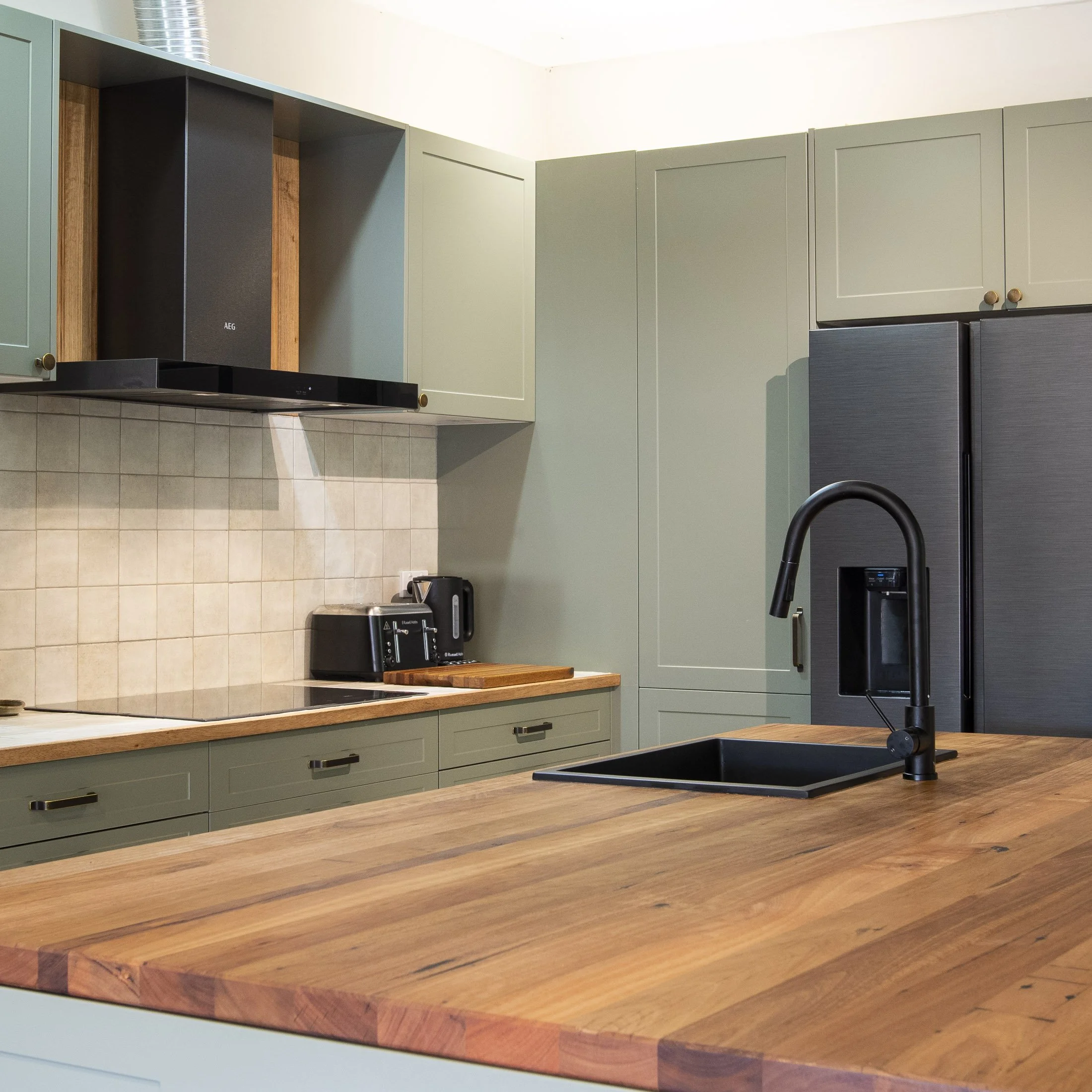What does the process of a glue up actually entail?
We’ve been hard at work manufacturing bespoke pieces for customers since we opened 2 years ago, producing work from a range of timbers and for all sorts of uses: from kitchen benches to custom tops for existing furniture, desks, shelves, and more. The process isn’t complicated, but it takes a keen eye and careful hand to ensure the finish of your work.
1. Selecting the perfect pieces
Step one of any job is finding the right timber. As a reclaimed timber store, we luckily don’t have to look very far, but it still is important to ensure we’re finding the right wood for the job.
For our glue ups, you can visit us in store and pick out an indicative piece of timber (ie. to show the colour range you’re looking for), or pick out all of the exact pieces you want included, or you can tell us your general range or vibe and we can do the hard work for you. You can rest assured that you are picking from solid, long-lasting Australian hardwoods that have been rescued from landfill, so no matter what choice you make it’s a good one for the planet.
Our machinist Peter hard at work jointing a board.
2. Dressing for success
Once we’ve gotten your dimensions and any custom details in our system, we then prepare the timber for gluing up. Our machining team takes the timber and runs it through a series of machines, including a jointer, thicknesser, table saw, and drop saw, all of which allows us to ensure the top surface of your bench is as beautiful as can be, and the parts that will be glued together have tight joints and no gaps.
We like to rough dress our timber to size and then let it sit for a week or more too – timber is a natural material and sometimes like to bend or move a little after we’ve machined it, so by letting it sit we can remove as much of that internal tension as possible in the timber and ensure it’s in the best possible state to be glued up and installed.
3. Laying out and your design consultation
Once all the timber is prepped and ready to go, there’s one final step. For every job, we lay out all the pieces and do a final check and dry fit to make sure the glue up is as perfect as can be.
It’s at this point that, if you’ve booked in a design consult, you can come in and be part of the process, including swapping around pieces so they’re in the exact order you want, or highlighting specific details in the timber such as grain or a live edge, or historical features such as nail holes, iron stains, and more.
Once this is all locked in, it’s go time: we’re ready to glue it all up!
4. Time to glue everything up
It’s can be a bit terrifying getting the glue out, but luckily our team have years of experience manufacturing beautiful bench tops, so fear not!
We use high quality PVA glue, and the glue joins end up being stronger than the timber itself (which is already pretty damn tough), and we manufacture our own hardwood timber joiners: these are inserted invisibly in the middle of your glue up to provide a bit of additional strength to the joints and help keep everything aligned. Don’t worry though, you’ll never even notice they’re there!
After letting everything thoroughly dry, we scrape off any excess beads of glue and do a final run through our thicknesser to clean up and flatten the top and bottom surfaces ready for sanding. Our team can absolutely report: there’s nothing quite like the feeling of a big, beautiful glue up coming out the end of the thicknesser and looking like a million bucks!
5. Custom details
No benchtop or table is complete without some finishing touches, and we offer a range of options for your custom piece. We include a standard range of corner and edge radiuses in the base glue up cost (and have samples in store of them all for you to look through), and can do custom routing or detailing for a small additional fee.
A great example is a recent order where we matched the existing edge profile of another piece of furniture in a customer’s home, so their new tabletop fit in perfectly.
It’s at this point that we also give your bench a thorough sand, smoothing out the timber and leaving a surface ready to shine with a bit of finish on it.
A detail of timber grain next to a sink. This bench had to be made in two pieces in order to fit up the stairs to the client’s flat!
6. Finishing up the process
Before it’s ready for pickup, the final step is that we fill and finish all of our glue ups as standard. We use tinted black beeswax for filling any small gaps, nail holes, or natural timber features, and finish all of our work with three coats of Livos’ Countertop Oil - a stunning looking and long-wearing oil wax blend that’s food safe and easy to refinish as necessary.
We also stock Livos’ products in store, so if your bench is starting to look a little thirsty from loving use, you can visit us in store and stock up.
Filling and finishing your benchtop comes included in the standard price, but we offer a small discount if you’d prefer us not to finish it in store: perfect for builders and tradies who’ll handle the install themselves, or for the adventurous DIY-ers who are excited to get their hands a bit dirty and really make the place feel like home.
Our machining and bespoke team bring both years of experience in timber manufacture as well as a desire to make pieces that perfectly fit your space and needs, including offering design consults, and the ability to hand pick timber from our on-site stock that suits your project. Get in touch today to find out more, or get an instant quote for your glue up today!










